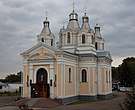Kobryn
Kobryn (Belarusian: Кобрын; Russian: Кобрин; Polish: Kobryń; Lithuanian: Kobrynas; Ukrainian: Кобринь, romanized: Kobryn'; Yiddish: קאברין) is a city in the Brest Region of Belarus and the center of the Kobryn District. The city is located in the southwestern corner of Belarus where the Mukhavets River and Dnepr-Bug Canal meet. The city lies about 52 km east of the city of Brest. Kobryn is located at Latitude 52.12.58N and Longitude 24.21.59E. It is at an altitude of 485 feet. It is a station on the Brest – Homiel railway line. As of 1995, the population was around 51,500. Sometimes the name of the city is written as Kobrin which is a transliteration from Russian.
Kobryn Кобрын | |
|---|---|
Kobryn, centre of town | |
 Flag  Coat of arms | |
 Kobryn Location in Belarus | |
| Coordinates: 52°13′0″N 24°22′0″E | |
| Country | |
| Region | Brest Region |
| District | Kobryn District |
| First mentioned | 1287 |
| Government | |
| • Chairman | Mikhail Grishkevich |
| Area | |
| • Total | 26 km2 (10 sq mi) |
| Population (2009) | |
| • Total | 51,166 |
| • Density | 2,000/km2 (5,100/sq mi) |
| [1] | |
| Time zone | UTC+2 (EET) |
| • Summer (DST) | UTC+3 (EEST) |
| Postal code | 225301—225306, 225860 |
| Area code(s) | +375 1642 |
| License plate | 1 |
| Website | Official website (in Russian) |
History
In prehistoric times it was inhabited by the ancient Baltic Yotvingian tribe. At various times, the city had belonged to Kingdom of Galicia–Volhynia, the Grand Duchy of Lithuania, the Polish-Lithuanian Commonwealth, the Russian Empire, the Second Polish Republic, the Byelorussian SSR and the Republic of Belarus.
Middle Ages and early modern era
.png)
In the 10th century the area became part of the emerging Polish state under first ruler Mieszko I of Poland.[2] Later on, the area was part of the Kievan Rus' and the Kingdom of Galicia–Volhynia.[2] Kobryn was first mentioned in 1287.[2] In the early 14th century the town formed part of the Grand Duchy of Lithuania, after the Union of Krewo (1385) in the Polish–Lithuanian Union. It became the capital of a feudal principality within the Polish–Lithuanian realm, existing from 1387 to 1518.[2] In 1500, princess Anna Kobryńska founded the Catholic church of the Assumption of the Virgin Mary.[2] After 1518, Kobryn was ruled by Queen Bona Sforza, who contributed to its development and visited it several times.[2]
A seat of a powiat authorities, in between 1589 and 1766 it was a royal city of the Polish–Lithuanian Commonwealth, located on Magdeburg Law. This allowed for a large number of Jews to settle in the area following the 16th century. The Jewish population in 1900 was 6,738.[3] In Kobryń was held the county Sejmik of the Mozyrz County during the Russian occupation of Mozyrz in 1659.[4] In the years 1774–1784 a canal was built connecting the Mukhavets River with the Pina River, named the Royal Canal after Polish King Stanisław August Poniatowski, who opened it, and as a result a water route was created connecting the Baltic Sea and the Black Sea.[2]
Late modern era
.jpg)
After the Partitions of Poland of 1795, the town was annexed by Imperial Russia. Catherine II gave Kobryn to Field Marshal Alexander Suvorov for his war merits, especially for the suppression of the Polish Kościuszko Uprising.[2] After the unsuccessful January Uprising anti-Polish repressions intensified: estates were confiscated, insurgents and landowners were deported to Siberia (see: sybirak) and a ban on land acquisition by ethnic Poles was introduced.[2] Kobryn was occupied by Germany during World War I.
Kobryń came under Polish control in February 1919,[5] four months after the reestablishment of independent Poland.[2] During the Polish–Soviet War it was the site of the victorious Polish Battle of Kobryń in September 1920. Polish rule was confirmed under the terms of the Treaty of Riga in 1921 and Kobryń became a seat of a powiat within the Polesie Voivodeship. After the war, crafts, small industry and trade developed again, and small factories were established.[2] In 1923, the State Gymnasium was founded, which three years later received the name of Maria Rodziewiczówna, a Polish writer living nearby, who co-financed the construction of the school.[2]
World War II and recent times
.jpg)
During the 1939 Invasion of Poland of the town was the scene of the Battle of Kobryń between the Polish 60th Infantry Division of Colonel Adam Epler and the German 19th Panzer Corps of General Heinz Guderian. After three days of fighting, the Poles withdrew southwards and the Germans entered the town, which they three days later handed over to the Soviets in accordance with the Molotov–Ribbentrop Pact. On 14 November 1939, Kobryn was incorporated into the Byelorussian SSR.
From 23 June 1941 until 20 July 1944, Kobryn was occupied by Nazi Germany and administered as a part of the Generalbezirk Wolhynien-Podolien of Reichskommissariat Ukraine. During the latter period, the majority of Jewish inhabitants were first amassed in a ghetto and then murdered by the Nazis in their extermination camps.
Two Polish priests, The Reverend Władysław Grobelny and Jan Wolski from Kobryń near Brześć, arrested for helping the Jews, were executed on October 15, 1942 together with a number of Jews from the Brześć ghetto.[6][7]
In 1944, the town was liberated by the Red Army. Since 1991, it is a part of the independent Republic of Belarus.
Sights
Among the historical monuments of the city are the Catholic Church of the Dormition, Baroque Monastery of the Transfiguration, a park founded by Antoni Tyzenhauz in 1768, the Orthodox church of St. Alexander Nevsky, the building of the pre-war Polish Maria Rodziewiczówna State Gymnasium, the building of the pre-war town hall and the Catholic cemetery, where the family of the Polish national poet Adam Mickiewicz is buried.
 Church of the Dormition
Church of the Dormition- Monastery of the Transfiguration
 Church of St. Alexander Nevsky
Church of St. Alexander Nevsky Maria Rodziewiczówna State Gymnasium building
Maria Rodziewiczówna State Gymnasium building.jpg) Former town hall
Former town hall Grave of the Mickiewicz family at the Catholic cemetery
Grave of the Mickiewicz family at the Catholic cemetery
See also
- Battle of Kobryń
- Kobryn (disambiguation)
References
- "World Gazetteer". Archived from the original on 2013-01-11.
- Bohdan Miłaczewski. "Zarys dziejów ziemi kobryńskiej i jej mieszkańców". Echa Polesia (in Polish). Retrieved 7 October 2019.
- JewishGen.org
- Wojciech Kriegseisen, Sejmiki Rzeczypospolitej szlacheckiej w XVII i XVIII wieku, Warszawa 1991, p. 33
- Lech Wyszczelski, Wojna polsko-rosyjska 1919–1920. Wyd. 1. Bellona, Warszawa, 2010, p. 56, 58
- Zajaczkowski, Waclaw (1988). Martyrs of Charity: Christian and Jewish Response to the Holocaust. St. Maximilian Kolbe Foundation. p. 164. ISBN 0945281005.
- "ks. Władysław Grobelny, wikariusz z parafii w Kobryniu | Pamięć i Tożsamość | MIĘDZYNARODOWE CENTRUM INFORMACYJNE". pamiecitozsamosc.pl. Retrieved 2019-06-12.
Further reading
- T.A.Khvagina (2005) POLESYE from the Bug to the Ubort, Minsk Vysheysha shkola, ISBN 978-985-06-1153-6 (in Belarusian, Russian and English)
- Ye.N.Meshechko, A.A.Gorbatsky (2005) Belarusian Polesye: Tourist Transeuropean Water Mains, Minsk. (in Russian, English and Polish)
External links
| Wikimedia Commons has media related to Kobryn. |
- Tourist Kobrin
- Coat of Arms
- Photos on Radzima.org
- Jewish Kobrin – Your Virtual Shtetl
- Pictures of Kobrin
- Kobryn cemetery
- A virtual tour of the city Kobrin
- Kobryn, Belarus at JewishGen
